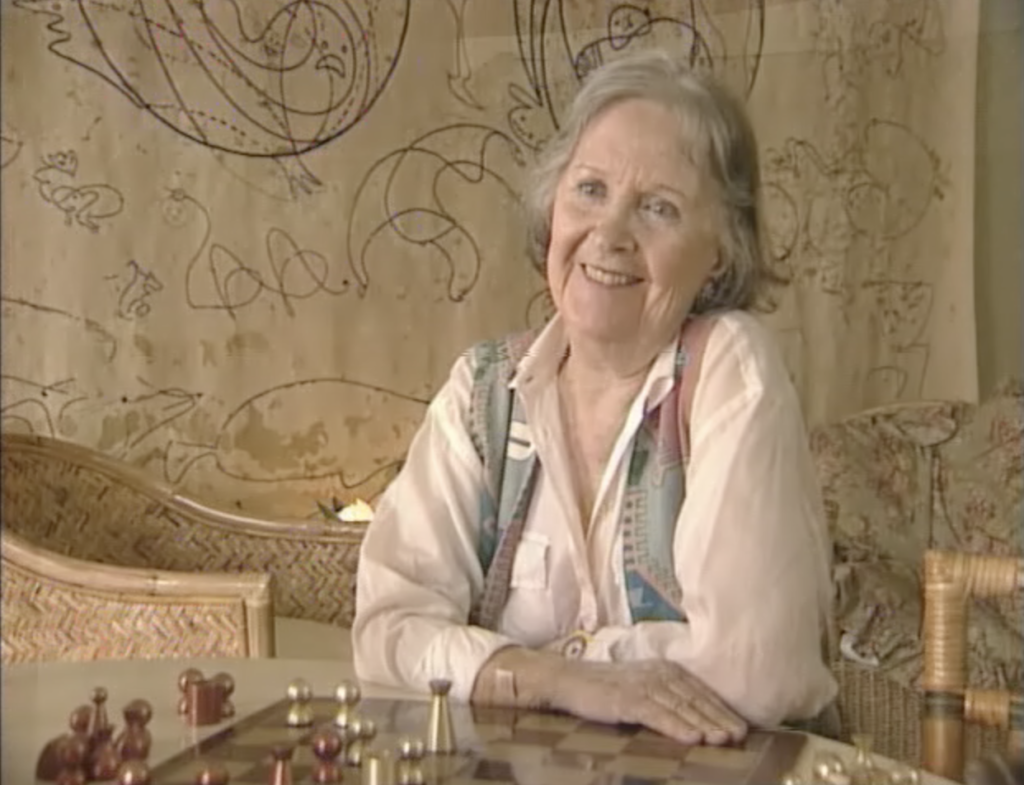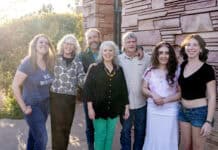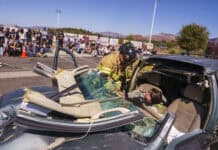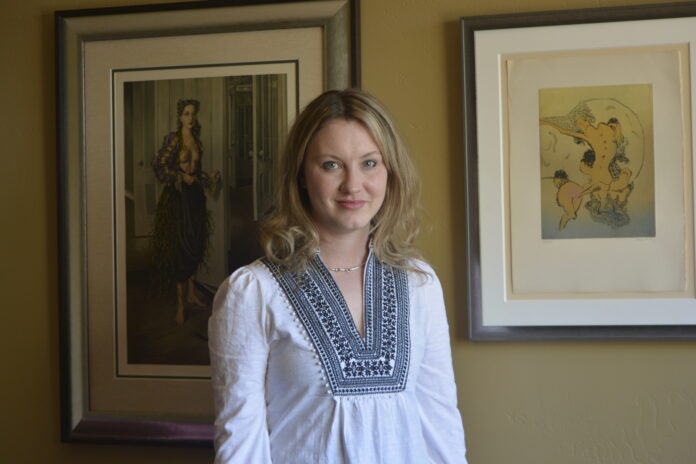When one door closes, another opens is a metaphor that expresses the end of one situation and is often followed by the start of a new one. In Surrealism, doorways have a symbolic meaning, often revealing a portal into the unconscious mind.
Surrealist Dorothea Tanning explained her interpretation of the doors she painted, saying, “I had been struck, one day, by a fascinating array of doors — hall, kitchen, bathroom, studio — crowded together, soliciting my attention with their antic planes, light, shadows, imminent openings and shuttings. From there, it was an easy leap to a dream of countless doors. Moreover, alone and taking stock of myself, I felt a sort of immanence as if my life was revealing itself at last—a real birthday.”

That imagery inspired Tanning’s renowned painting, “Birthday,” a self-portrait of the artist standing in a room, half-clothed with a multitude of doors ajar. She explained in her autobiography, “Everything is in motion. Also, behind the invisible door another door. There is no showing who one is.” Tanning suggested a rebirth from the real into the surreal in her work.
Recently, Tanning’s work, among other surrealist female artists, has been gaining notoriety in the art world. Her painting, “Le Mal Oublié,” [The Ill Forgotten] sold at auction at Christie’s New York for a record price of $1,440,000.
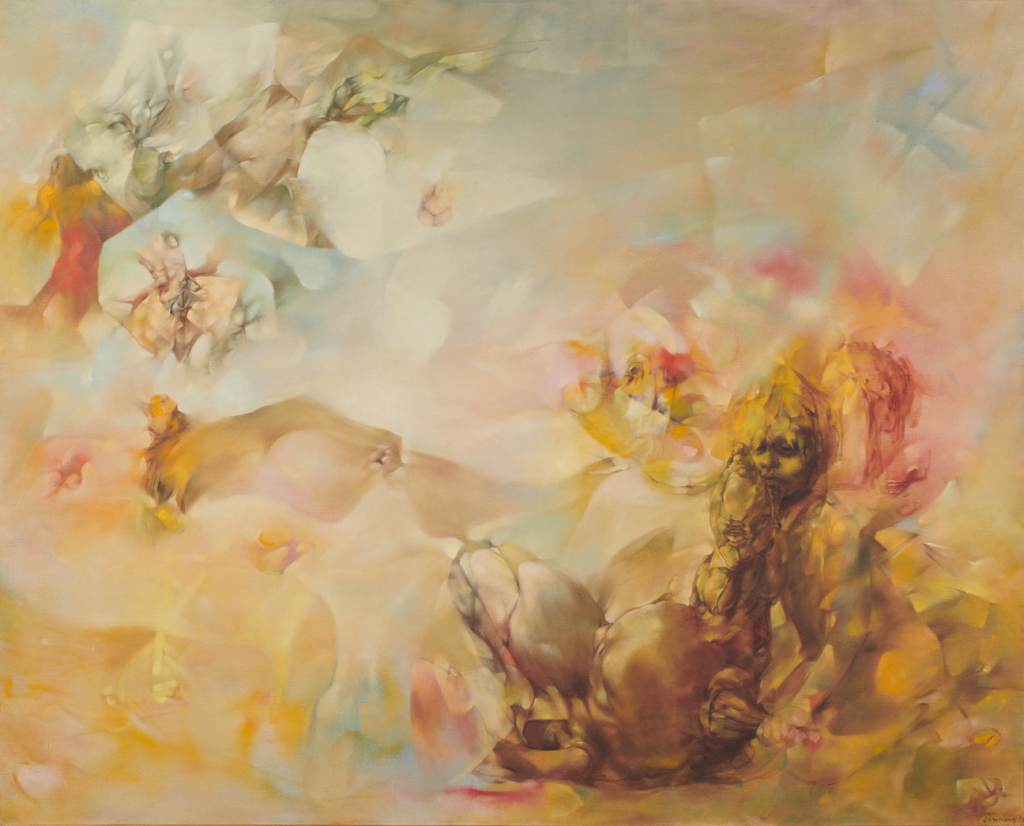
“Around 1955, my canvases literally splintered. Their colors came out of the closet, you might say, to open the rectangles to a different light. They were prismatic, surfaces where I veiled, suggested and floated my persistent icons and preoccupations, in another of the thousand ways of saying the same things, -from Between Lives: An Artist and Her World. New York: W.W. Norton & Company, 2001, p. 178. https://www.dorotheatanning.org/life-and-work/view/114/
In the mid-1940s, Surrealists Tanning and her husband, Max Ernst, impressed with Sedona’s beauty and landscape, built a home off Brewer Road and lived there from 1943 to 1957.
Tanning appropriately named it “Capricorn, Hill,” writing in her autobiography, “…In Arizona, there was nothing about our made-it-myself two-room house that visibly merited a name, Capricorn Hill. Alone it stood, if not crooked at any rate somewhat rakish, stuck on a landscape of such stunning red and gold grandeur that its life could be only a matter of brevity, a beetle of brown boards and tar paper roof waiting for metamorphosis.”
Uncovering clues
Earlier this year, almost 65 years later, the metamorphosis took shape — a bit of real-life surrealism occurred on “Capricorn Hill.” A door swung open for Sedona resident, artist, and art historian Mark Rownd, who purchased the home on the hill.
Ironically, Rownd has been gathering historical information and artwork about the two surrealists for more than eight years and is writing a book about his discoveries. For years, clues have serendipitously fallen in his tracks, including the home and art studio of Ernst and Tanning. Rownd says that he feels a sense of obligation to reveal its meaning.
“I’m still always surprised when [things about Tanning and Ernst] happen; it’s the frequency that they’re happening,” Rownd said.
I guess I’m less in shock than I used to be. Every time it happens, it keeps up until I try to study and figure out what just happened here. I’m trying to comprehend what it means. So, it’s strange. I don’t take it for granted. There will be another one tomorrow. I don’t have any theory as to why it happened. But it is happening.”

“In that camera-sharp place where planetary upheaval had lift its signature: the now placid monuments that, as far as anyone out there cared, had been there forever, I would undertake—”dare” would be a truer word—to paint the unpaintable. One year was enough to sear it on the lens of memory (It was not done on the spot, as artists generally did: planting their shaky easels in sand or shale, wind and sun; dipping brushes in globs of paint and hope) so that, in the studio alone with my dream I would record it like a diary entry, just like that, ” –from Dorothea Tanning: Birthday and Beyond. Exhibition brochure. Philadelphia: Philadelphia Museum of Art, 2000. https://www.dorotheatanning.org/life-and-work/view/230
Rownd has found artifacts pertaining to Tanning and Ernst at the homesite, surveyed locations they visited or painted from, discovered art through auctions, met strangers with connections to the two artists, spent years of research connecting the dots and now owns the home they once lived in. Rownd has since turned the home into a historic tribute to the Surrealists.
Rownd, a graduate of Rice University in Houston, Texas, studied art history. According to Rownd, his interest in surrealism began at the Menil Foundation, which houses one of the largest collections of Max Ernst. Upon moving to Sedona, Rownd was surprised to learn that just a handful of the residents realized the significance of Tanning and Ernst and what they represented to the art world.
“That’s when I decided the town didn’t know anything about its art history, and I had an exhibition to educate Sedona. I took it upon my own,” Rownd said. “I rented the special exhibition hall at the Sedona Art Center in 2014. I bought art from all over the place to have a representation of Tanning and Ernst’s work and try to tell the story of the art they did while they were here. And that officially began my journey.”

1. The peril of angels and geniuses: “Snow is falling. We are out with our sleds which we hook onto the tailgates of heavy wagons. We all wear padded boots but there is one child, and that is me, whose feet are like two chunks of ice in their boots. Scene: the snow-covered lawn in front of our house. Lying on my back in the snow I raise my arms and slide them down in the cold white powder. When I get up I have left my print: an angel.
“Evening. The whole family is seated under the lamp, around the library table. I am drawing an angel, all naked except for the wings which are feathered, a lady angel with round breasts and a sweet smile. My mother doesn’t like my drawing. Lifting my eyes I see them all looking at me as if I were a stranger, the whole family. It’s a good thing that I keep my other drawings upstairs, hidden in my toy drawer. They are not inspired by the picture (the only one) hanging on the wall of our dining room, a chromo-lithograph of a Boecklin. It is called Heiliger Hain and shows a procession of veiled figures gliding towards an altar in the forest. I detest this picture as much as I can detest anything. It is profoundly abhorrent to me and makes me think of Sunday mornings in our church and the sermons treating of hell and damnation; there, where I am obliged to sit mouse-quiet for an hour every week, listening to the detailed menaces of divine vengeance which God has reserved for us humans.
“So whether the gaze is out on the flat landscape punctuated by neat boxy houses each locked in its rectangular island of grass, or in the dining room with the melancholy shrouds of Heiliger Hain, both views are insupportable and so I look inside of me. And lo! there are mountains a mile high with waterfalls like Rapunzel’s hair. There is a forest so full of yellow eyes it gives off a sulphur glow. And into the grisaille of our nostalgia pour the wonderful colors of imagination. A way of lighting the labyrinth, of leading a life as extravagant as that of a Bavarian prince who, of course, is also a poet,” –from “Dorothea Her Lights and Shadows (A Scenario).” Translated from XXe Siècle, Paris, September, 1976. Reprinted in Dorothea Tanning: 10 Recent Paintings and a Biography. Exhibition catalogue. New York: Gimpel-Weitzenhoffer Gallery, 1979, pp. 26-27. https://www.dorotheatanning.org/life-and-work/view/66
31 Women Artists Exhibition at SAC
In 2020, Rownd suggested to then Executive Director of the Sedona Arts Center, Vince Fazio, to do an exhibition “31 Women Artists,” as an ode to Peggy Guggenheim, who in 1943, launched a special exhibition entitled “Exhibition by 31 Women at her Art of This Century Gallery in NYC, and where Tanning’s work was unveiled.
Rownd, had connected with Catriona McAra, Ph.D., who, at the time, was at the University of Leeks in West Yorkshire, England. She is known for her extensive knowledge as an author, researcher and leading authority on the work of Dorothea Tanning and Leonora Carrington — two feminist-surrealist legacies in early twenty-first-century art. McAra is now the Assistant Director, University Collections and Curation at the University of St. Andrews in Scotland.
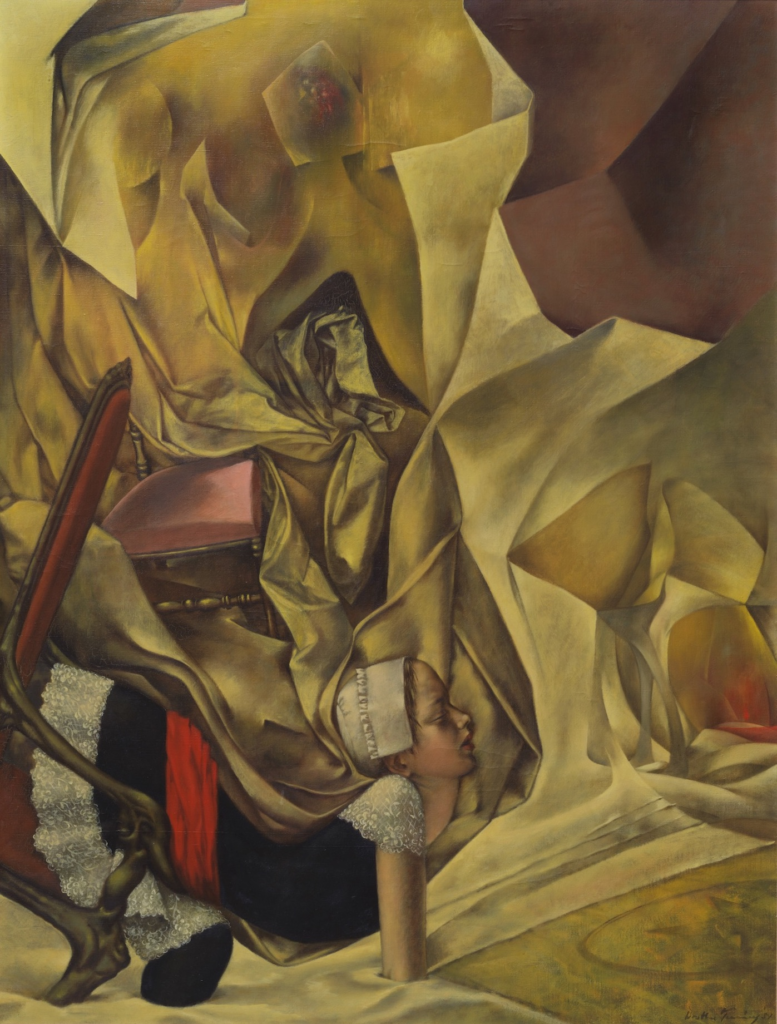
Simon Morley: Your painting seems to have gone through some great changes. Your early work was very precise and then suddenly it becomes more painterly, when and why did this happen?
Dorothea Tanning: I can’t tell you exactly, but I think that it’s a normal evolution in someone’s work: they find different ways of saying the same thing. One expresses one’s own preoccupations but I think one does this in a very different way. Maybe I just became a better painter, at least that was what I was always striving to do. If I didn’t paint in a very meticulous way afterwards maybe that was because I thought that that was not the best way. Too easy: it would have been like knitting or embroidery.
S.M.: The occult symbolism in your work: is it there because you believe, or because it is an available set of images?
D.T.: I was intrigued by it, still am, and during my youth I just read, read, read all this wild literature and this probably is what made me such a ‘literary’ painter. I was fascinated by things that I read — Gothic novels and what not. The occult is a wonderful subject,”
–from interview with Simon Morley, “Dorothea Tanning: The Art in Being Surreal,” Art Line International 4, no. 9 (1990), p. 43. https://www.dorotheatanning.org/life-and-work/view/74
“Mark Rownd recommended me as the guest curator, which is very kind of him. I think it was the first time Mark and I have met in person, but we’d been exchanging emails for many years,” McAra said. “He knew about my curatorial work. He knew about my writing, and it just seemed like it was a good match and a really interesting project to recreate Peggy Guggenheim’s 31 Women but using contemporary artists to achieve them.”
One of the artists who McAra selected for the exhibition was Amy Ernst — an artist in her own right — and granddaughter to Max Ernst, and daughter to Jimmy Ernst, an abstract painter.
“When I saw Amy’s work, that just did something to me, McAra said. “It was a piece called “Mantis,” a printmaking collage. It was one of the pieces that stood out to me as something interesting.”
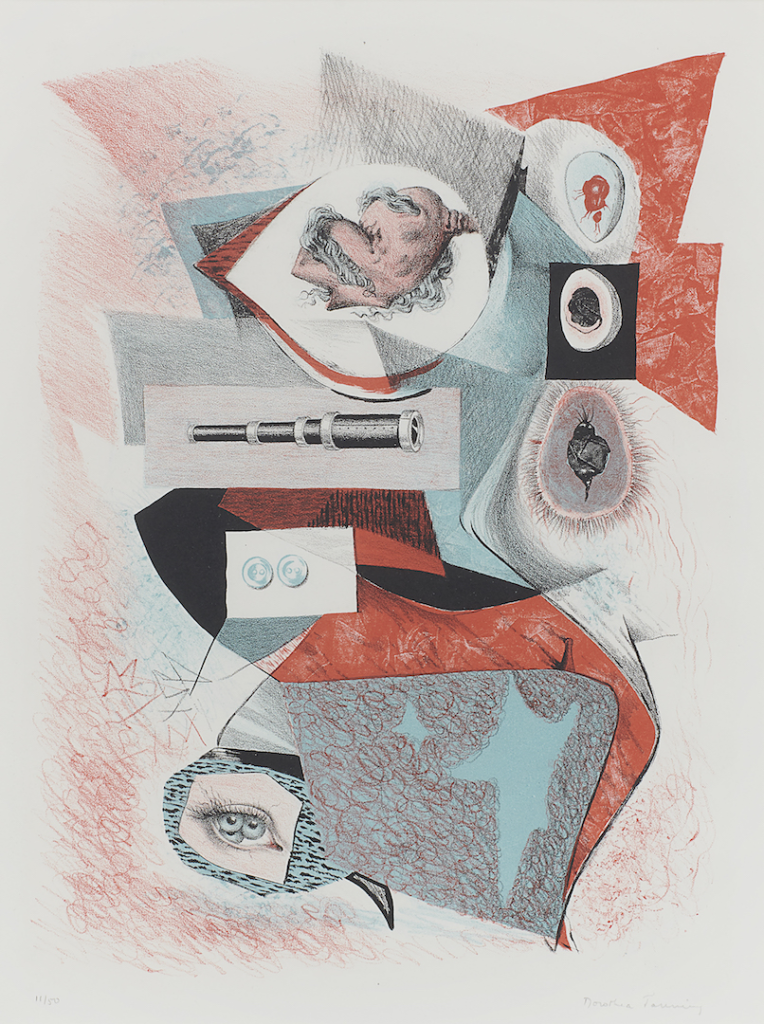
“My first lithograph adventure has become a book. An album with seven perils in it. Because to the seven deadly sins I preferred the seven spectral perils, life being more perilous than sinful. The writer, a good judge of both, naturally agreed. You might say that these interrogate the stone. And the stone, like an oracle, answered sometimes with effects never possible to achieve with other materials. The book’s cover was also a lithograph printed on a blue paper that, alas, soon discolored,” –from Dorothea Tanning: Hail Delirium! A Catalogue Raisonné of the Artist’s Illustrated Books and Prints, 1942-1991, New York: The New York Public Library, 1992, p. 89. https://www.dorotheatanning.org/life-and-work/view/208
Two art historians visit Sedona
McAra, along with Amy Ernst, who, as a child, lived in Sedona briefly with her parents, and Amy Lyford, professor of art history at Occidental College in Los Angeles, convened at Capricorn Hill to discuss their research and findings. McAra described the gathering “as conversations that come from people with mutual interests.”
“That’s just quite magical when something or some idea can bring three women together from completely different parts of the world, working on completely different things, then have a conversation and share ideas, fears and desires. That’s amazing.
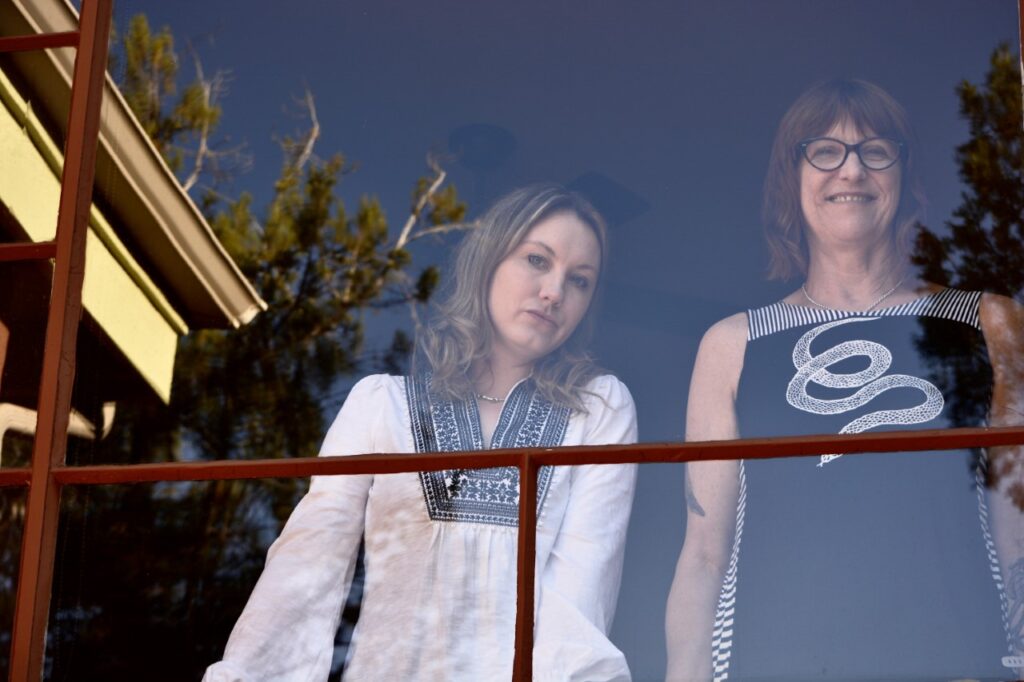
Rownd took his guests on a tour of Sedona, noting the places he discovered Ernst and Tanning visited, including She-Kay-Ah Ranch, a property near Los Abrigados Resort, once owned by artist Lillian Wilhelm Smith, and the scene of one of Tanning’s paintings.
Tanning, infatuated with Sedona, describes Arizona as a ‘landscape of wild fantasy.’ She left an indelible mark of the rugged terrain within several of her paintings, including “Self Portrait,” [1944], which includes a figure of herself standing at the edge of a body of water surrounded by the monolith rocky structures of Sedona.
Tanning described her experience in Sedona, “In that camera-sharp place where planetary upheaval had left its signature; The now placid monuments that, as far as anyone out there cared, had been there forever, I would dare to paint the unpaintable. One year was enough to sear it on the lens of memory.”

Historians meet Dorothea Tanning
McAra and Lyford are collaborating with the Scottish National Gallery of Modern Art, their research library. They’re hoping to find a base for a show in Sedona of Tanning’s work. It’s extraordinarily exciting to be here on the ground doing field research where she lived in her home, in her studio,” McAra said. “This is almost unheard of for scholars at this time.”
Both McAra and Lyford met Tanning before she passed away in 2012 at the age of 101.

“….I’ve always been attracted by the fantastic. You see I was born in Galesburg, a hamlet of Illinois, which is nothing exciting in itself, but my father, of Swedish origin, a very authoritarian man …
Marcel Duhamel: This is particularly evident in Family Portrait, where all the characters are represented in proportion to the importance they had then in your eyes. Looks like you settled accounts?
Not really … It is more generally a comment on the hierarchy within the sacrosanct family. My father, despite everything, brought us a breath of exoticism. He told stories of distant snows, the fleeing boy skates on the ice, fast, fast … the wolf at his heels … I felt the hoarse wolf breath on my neck … it was delicious.” —from interview with Marcel Duhamel, Dorothea Tanning: Numéro Spécial de XXe Siècle. Paris: Editions XXe Siècle, 1977, p. 110. https://www.dorotheatanning.org/life-and-work/view/78
“I met her on my 23rd birthday in 2008,” McAra, said. “And she was 98 at the time. I took her some sunflowers because I felt that would be appropriate. I wanted to know if she read the Grimm Fairy tales as a child. She confirmed to me that, indeed she did. And she loved him — especially the illustrations.
Lyford said she met Tanning in 1996, who was 86 at the time “I was interested in her soft sculpture that I had recently discovered in my research that she had designed and oversaw the construction of the house in southern France where she and Max lived … she had a twinkle in her eye, was very perky and seemed happy to see me, but she did say, ‘you know, the only reason I agreed to see you and allow you to interview me, is because you’re asking about things nobody’s ever asked me about before.’ She asked me to turn off the recorder and said, ‘and now we will have champagne.’”

Unheard of News – a Dorothea Tanning discovery unveiled
Over the last few years, there has been a lot of interest in Tanning’s work. The Tate Modern in London exhibited 100 pieces of artwork in 2019, surveying over 75 years of Tanning’s career. And previously at the Museo Reina Sofia in Madrid.
“She is starting to get more of a following, but she’s vastly under-acknowledged in art history. And yet, so much of her work is so powerful and pertinent today, especially to feminist artists and writers.” McAra said. “We’re tremendously excited to create critical attention if we can. And specifically, for this very, very particular project we have. Well, I should say, Amy has found.”
Lyford, who has been researching Tanning for a multitude of years, discovered a screenplay that has yet to be acknowledged that Tanning wrote in the 1980s, titled “Unheard of News.” “It’s revolutionary, McAra stated.
“Unheard of News” is a satirical documentary film on paintings of Tanning. Tanning writes the screenplay and storyboards about climate control.
“When I found this screenplay and these storyboards, I wanted to know about it because I thought, can you believe that there’s this thing that nobody’s ever talked about, Lyford said. “I mean, that’s the crazy thing about this screenplay. And it sheds light on an entire facet of her interest in film that has just not been part of the standard narrative.”
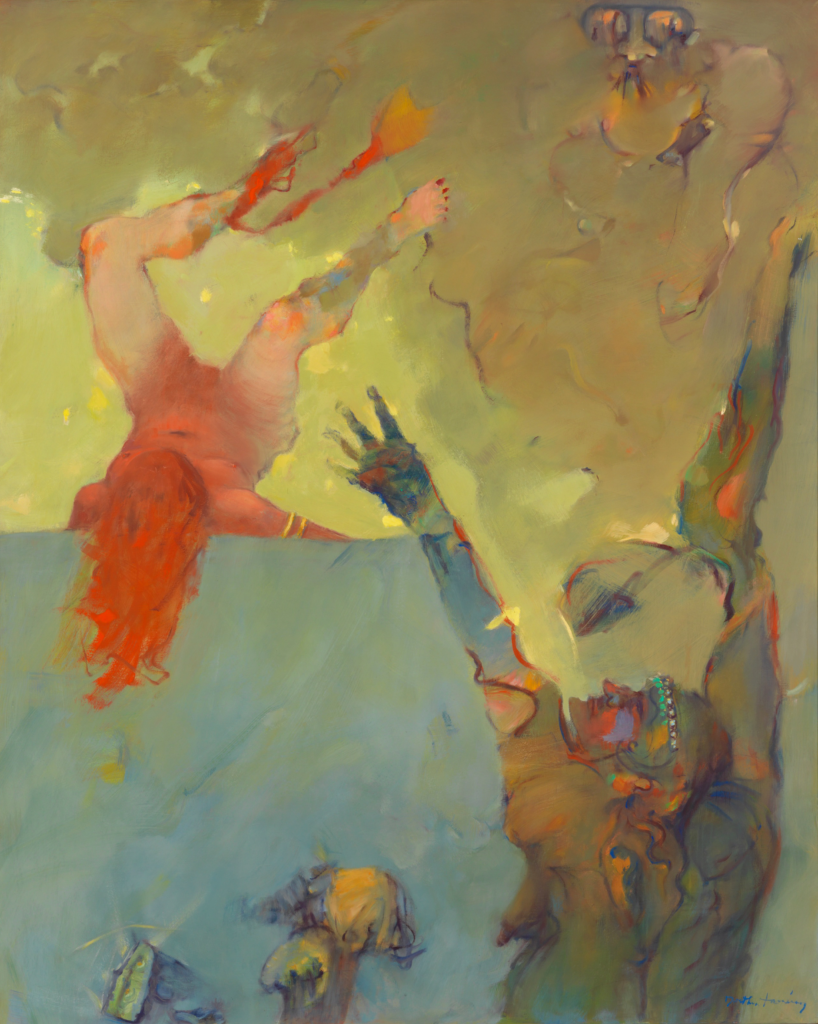
“Alain Jouffroy: Is that the special kind of violence in your work, the violence of bodies rebelling, rising, to confront an enemy as it were. What is that enemy?“
“Civilization, you might say. But these bodies are more of an affirmation. They may be symbolic of violence, but also of the ferociousness of encounters, of the wonderful will of human beings to prove their ancestry over the forces of so-called civilization,” -from “Interview with Dorothea Tanning” in Dorothea Tanning, retrospective exhibition catalogue, Malmö, Sweden: Malmö Konsthall, 1993, p. 57. This interview was originally published as “Questions pour Dorothea Tanning entretien avec Alain Jouffroy, Mars 1974,” in Dorothea Tanning: Oeuvre, retrospective exhibition catalogue, Paris: Centre National D’Art Contemporain, 1974. https://www.dorotheatanning.org/life-and-work/view/384
Lyford said she became a sleuth, uncovering documents buried in archives in renowned museums across the country. She discovered papers from gallerist Julian Levy, films from Hans Richter and papers of the photographer and cinematographer who worked on several of Richter’s films, including the ones in which Tanning and Ernst performed.
“I think that her interest in film, especially in “Unheard of News,” project she wrote a screenplay. And she even mocked up how the camera would move through the film,” Lyford said. “She was doing storyboards of a fake interview, asking her about her career. But there were also these moments where we sense flood and fire. And this is where the climate change angle comes out. With a camera, she looked at her paintings and moved the camera around the paintings, stopping on one detail and then moving to another. And I think it’s an insight into her deep investment in film, her effort to frame her career. It’s really powerful. She wanted a self-presentation rather than being described by others from their perspective. And I think that’s why we’re so excited about bringing this material out.”
Lyford’s book, which entails her findings, is due to come out later this year. In addition, Rownd has discovered clues to Tanning’s work, which he describes as “Native American influences and folklore of the Hopi.” He is not ready to reveal the totality of his findings, leaving the door ajar for more information to unfold, serendipitously.
